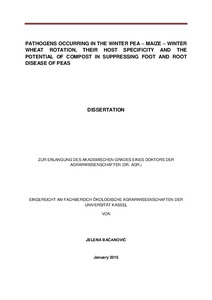| dc.date.accessioned | 2015-09-17T09:07:40Z | |
| dc.date.available | 2015-09-17T09:07:40Z | |
| dc.date.issued | 2015-09-17 | |
| dc.identifier.uri | urn:nbn:de:hebis:34-2015091749047 | |
| dc.identifier.uri | http://hdl.handle.net/123456789/2015091749047 | |
| dc.language.iso | eng | |
| dc.rights | Urheberrechtlich geschützt | |
| dc.rights.uri | https://rightsstatements.org/page/InC/1.0/ | |
| dc.subject | Pathogens | eng |
| dc.subject | Maize | eng |
| dc.subject | Peas | eng |
| dc.subject | Wheat | eng |
| dc.subject | Compost | eng |
| dc.subject | Fusarium | eng |
| dc.subject | Ascochyta | eng |
| dc.subject | Root rot | eng |
| dc.subject.ddc | 630 | |
| dc.title | Pathogens occuring in the winter pea-maize-winter wheat rotation, their host specificity and the potential of compost in suppressing foot and root disease of peas | eng |
| dc.type | Dissertation | |
| dcterms.abstract | The overall aim of the work presented was to evaluate soil health management with a specific focus on soil borne diseases of peas. For that purpose field experiments were carried out from 2009 until 2013 to assess crop performance and pathogen occurrence in the rotation winter pea-maize-winter wheat and if the application of composts can improve system performance. The winter peas were left untreated or inoculated with Phoma medicaginis, in the presence or absence of yard waste compost at rate of 5 t dry matter ha-1. A second application of compost was made to the winter wheat. Fusarium ssp. were isolated and identified from the roots of all three crops and the Ascochyta complex pathogens on peas. Bioassays were conducted under controlled conditions to assess susceptibility of two peas to Fusarium avenaceum, F. solani, P. medicaginis and Didymella pinodes and of nine plant species to F. avenaceum. Also, effects of compost applications and temperature on pea diseases were assessed.
Application of composts overall stabilized crop performance but it did not lead to significant yield increases nor did it affect pathogen composition and occurrence. Phoma medicaginis was dominating the pathogen complex on peas. F. graminearum, F. culmorum, F. proliferatum, Microdochium nivale, F. crookwellense, F. sambucinum, F. oxysporum, F. avenaceum and F. equiseti were frequently isolated species from maize and winter wheat with no obvious influence of the pre-crop on the Fusarium species composition. The spring pea Santana was considerably more susceptible to the pathogens tested than the winter pea EFB33 in both sterile sand and non-sterilized field soil. F. avenaceum was the most aggressive pathogen, followed by P. medicaginis, D. pinodes, and F. solani. Aggressiveness of all pathogens was greatly reduced in non-sterile field soil. F. avenaceum caused severe symptoms on roots of all nine plant species tested. Especially susceptible were Trifolium repens, T. subterraneum, Brassica juncea and Sinapis alba in addition to peas. Reduction of growing temperatures from 19/16°C day/night to 16/12°C and 13/10°C did not affect the efficacy of compost. It reduced plant growth and slightly increased disease on EFB33 whereas the highest disease severity on Santana was observed at the highest temperature, 19/16°C. Application of 20% v/v of compost reduced disease on peas due to all four pathogens depending on pea variety, pathogen and growing media used. Suppression was also achieved with lower application rate of 3.5% v/v. Tests with γ sterilized compost suggest that the suppression of disease caused by Fusarium spp. is biological in origin, whereas chemical and physical properties of compost are playing an additional role in the suppression of disease caused by D. pinodes and P. medicaginis. | eng |
| dcterms.accessRights | open access | |
| dcterms.creator | Baćanović, Jelena | |
| dc.contributor.corporatename | Kassel, Universität Kassel, Fachbereich Ökologische Agrarwissenschaften | |
| dc.contributor.referee | Finckh, Maria R. (Prof. Dr.) | |
| dc.contributor.referee | Backes, Gunter (Prof. Dr.) | |
| dc.subject.swd | Erbse | ger |
| dc.subject.swd | Mais | ger |
| dc.subject.swd | Weizen | ger |
| dc.subject.swd | Pathogener Mikroorganismus | ger |
| dc.subject.swd | Kompost | ger |
| dc.date.examination | 2015-04-15 | |

